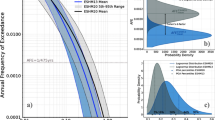Abstract
Physical-chemical explanations of the causes of variations in rock suites are evaluated by comparing predicted to measured compositions. Consistent data turn an explanation into a viable hypothesis. Predicted and measured values seldom are equal, creating problems of defining consistency and quantifying confidence in the hypthesis. Bayes theorem leads to methods for testing alternative hypotheses. Information available prior to data collection provides estimates of prior probabilities for competing hypotheses. After consideration of new data, Bayes theorem updates the probabilities for the hypotheses being correct, returning posterior probabilities. Bayes factors, B, are a means of expressing Bayes theorem if there are two hypotheses, H 0 and H 1. For fixed values of the prior probabilities, B > 1 implies an increased posterior probability for H 0 over its prior probability, whereas B < 1 implies an increased posterior probability for H 1 over its prior probability. Three common problems are: (1) comparing variances in sets of data with known analytical uncertainties, (2) comparing mean values of two datasets with known analytical uncertainties, and (3) determining whether a data point falls on a predicted trend. The probability is better than 0.9934 that lava flows of the 1968 eruption of Kilauea Volcano, Hawaii, are from a single magma batch. The probability is 0.99 that lava flows from two outcrops near Mount Edziza, British Columbia, are from different magma batches, suggesting that the two outcrops can be the same age only by an unlikely coincidence. Bayes factors for hypotheses relating lava flows from Volcano Mountain, Yukon Territory, by crystal fractionation support the hypothesis for one flow but the factor for another flow is so small it practically guarantees the fractionation hypothesis is wrong. Probabilities for petrologic hypotheses cannot become large with a single line of evidence; several data points or datasets are required for high probabilities.
Similar content being viewed by others
REFERENCES
Berger, J. O., and Delampady, M., 1987, Testing precise hypotheses: Statis. Sci., v. 2,no. 3, p. 317–352.
Davis, J. C., 1986, Statistics and data analysis in geology, 2nd Ed.: John Wiley & Sons, New York, 646 p.
Ghiorso, M. S., and Sack, R. O., 1995, Chemical mass transfer in magmatic processes. IV. A revised and internally consistent thermodynamic model for the interpolation and extrapolation of liquid-solid equilibra in magmatic systems at elevated temperatures and pressures: Contrib. Mineral. Petrol., v. 119,no. 2, p. 197–212.
Ghiorso, M. S., Carmichael, I. S. E., Rivers, M. L., and Sack, R. O., 1983, The Gibbs free energy of mixing of natural silicate liquids; an expanded regular solution approximation for the calculation of magmatic intensive variables: Mineral. Petrol., v. 84,no. 2, p. 107–145.
Jeffreys, W. H., and Berger, J. O., 1992, Ockham's razor and Bayesian analysis: Am. Scientist, v. 80,no. 1, p. 64–72.
Jeffreys, H., 1961, Theory of probability: Oxford University Press, Oxford, England, 459 p.
LeMaitre, R. W., 1982, Numerical petrology: Statistical interpretation of geochemical data: Elsevier Scientific Publishing Company, Amsterdam, 281 p.
Meyer, S. L., 1975, Data analysis for scientists and engineers: John Wiley and Sons, New York, 513 p.
Nicholls, J., 1990, Stoichiometric constraints on variations in Pearce element ratios and analytical uncertainty in hypothesis testing, in Russell, J. K., and Stanley, C. R., eds., Theory and application of Pearce element ratios to geochemical data analysis, v. 8: Geological Association of Canada, Vancouver, BC, p. 73–98.
Nicholls, J., and Stout, M. Z., 1988, Picritic melts in Kilauea—Evidence from the 1967–1968 Halemaumau and Hiiaka eruptions: Jour. Petrology, v. 29,no. 5, p. 1031–1057.
Nicholls, J., Russell, J. K., and Stout, M. Z., 1986, Testing magmatic hypotheses with thermodynamic modelling, in Scarfe, C. M., ed., Short course in silicate melts, v. 12: Mineralogical Assoc. of Canada, Toronto, p. 210–235.
Oviatt, C. G., and Nash, W. P., 1989, Late Pleistocene basaltic ash and volcanic eruptions in the Bonneville basin, Utah: Geol. Soc. America Bull., v. 101,no. 2, p. 292–303.
Schmitt, S. A., 1969, Measuring uncertainty, an elementary introduction to Bayesian statistics: Addison-Wesley Publishing Company, Reading, MA, 400 p.
Spooner, I. S., 1994, Quaternary Environmental Change in the Stikine Plateau Region, Northwestern British Columbia, Canada: unpubl. doctoral dissertation, University of Calgary, Calgary, 313 p.
Trupia, S., 1992, Petrology of nephelinites and associated ultramafic nodules of Volcano Mountain, Yukon Territory: unpubl. masters thesis, University of Calgary, Calgary, 123 p.
Trupia, S., and Nicholls, J., 1996, Petrology of Recent lava flows, Volcano Mountain, Yukon Territory, Canada: Lithos, v. 37,no. 1, p. 61–78.
Wright, T. L., 1971, Chemistry of Kilauea and Mauna Loa in space and time: U.S. Geol. Survey Prof. Paper, v. 735, no., p. 1–40.
Wright, T. L., Swanson, D. A., and Duffield, W. A., 1975, Chemical compositions of Kilauea east-rift lava, 1968–1971: Jour. of Petrology, v. 16,no. 1, p. 110–133.
Author information
Authors and Affiliations
Rights and permissions
About this article
Cite this article
Nicholls, J. Estimation of Probabilities of Three Kinds of Petrologic Hypotheses with Bayes Theorem. Mathematical Geology 30, 817–835 (1998). https://doi.org/10.1023/A:1021774525343
Issue Date:
DOI: https://doi.org/10.1023/A:1021774525343




